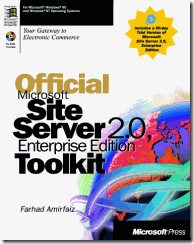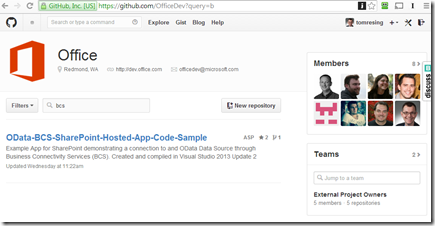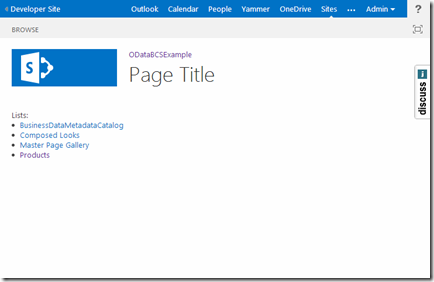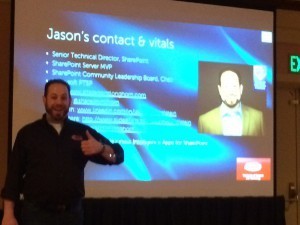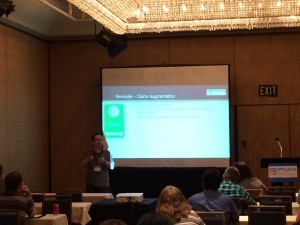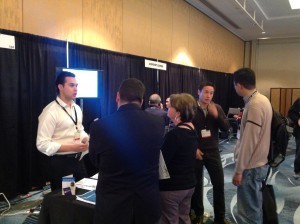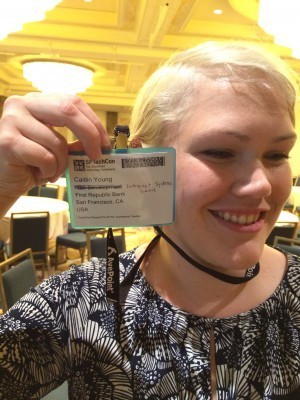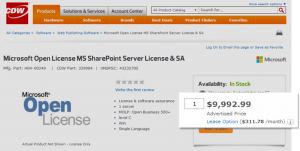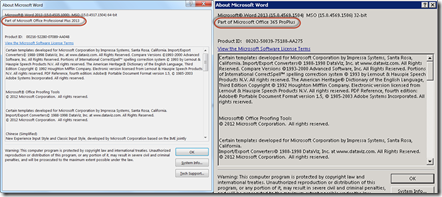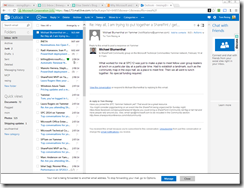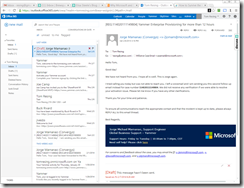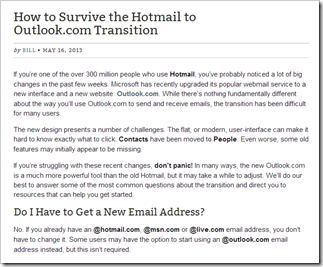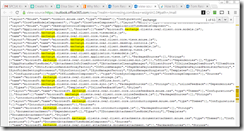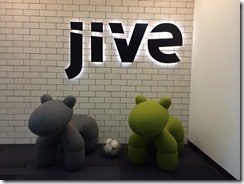Thomas Resing's Blog: Tom Resing's Collaboration Blog, page 5
June 25, 2014
Surface Pro 3 Stylus Drawing Test
The Surface Pro 3 arrived Friday. The stylus is new to me, so I put it through some tests. The stylus is in the shape of a pen. It has two buttons on the side, one on the top, a nub in place of a ball point and a wire clip that holds it in place on the strap next to the keyboard.

Surface Pro 3 Stylus
The articles I read about the stylus talk about how the top button opens OneNote instead of erasing, how the second button on the pen fills that need and how it’s only got 256 degrees of sensitivity. I tried out the first two points without much hurrah. The third point took a little more research to understand. First I tried testing it in OneNote. I couldn’t really see the effect. Next I tried the free SketchBook Express app. A lot of people like it, but I couldn’t really figure out how to change brushes. I don’t really expect to be able to do what they show in their screenshots in the app page, but I can see in 15 minutes of use, I need some training even to use the app.
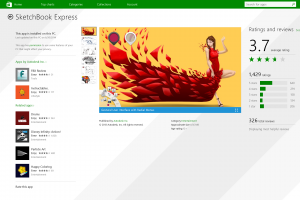
SketchBook Express
Fresh Paint doesn’t get the positive reviews of Sketchbook, but at least I could figure out how to change brushes.
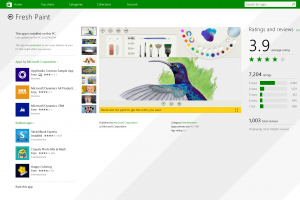
Fresh Paint App
Again, my efforts don’t look like the screenshots, but I can at least finally see the effect of the pressure sensitive pen. It’s going to take me awhile to figure out whether this really justifies the AAAA battery and two pen batteries and the supposed $100 retail value. However, here’s an example of lines of 5 different darkness I was able to draw with varying levels of pressure. I used the pencil tool. Paint brushes didn’t seem to show any difference in pressure to me.

Drawing with stylus
For comparison, below is screen capture of a drawing without the stylus. I drew five lines pressing with my finger on the tablet with varying pressure. As expected, it doesn’t make the lines lighter or darker.

Drawing with finger
Side Note
I only use this device to play around with it and Windows 8. Primarily, it’s my wife who uses it for work. I have to say, it’s the best Surface device I’ve used yet. As part of my experiment, I used the Metro or Modern version of Internet Explorer to write this whole post. Even though it felt a little awkward, I think I’d get the hang of it eventually. I could picture myself traveling with this Surface. I know my back would thank me if I replaced my 10 pound laptop with this 3 pound tablet.
References
If you want to read more about the Surface Pro 3, I recommend the following articles I’ve read by authors I trust:
Mary Jo Foley’s comparison to her new ultrabook on ZDNet
Paul Thurrott’s Full Review with lot’s of references
Cory Roth’s Review
Marc Anderson’s Review
Postscript
After figuring out the pencil darkness test in Fresh Paint, I revisited OneNote. I still can’t find a drawing tool in OneNote that draws lighter or darker based on pressure. However, I did find that if I change the pen to thick pen, I can vary the thickness of the pen by using more pressure or less.

OneNote Screenshot




June 3, 2014
Off with SharePoint’s Head? Or, bye Dad?
 @maryjofoley broke the news this morning that @jeffteper has been promoted. It’s great news for Teper in his continued rise up in Microsoft. What does it mean for SharePoint, the business he takes responsibility for creating?
@maryjofoley broke the news this morning that @jeffteper has been promoted. It’s great news for Teper in his continued rise up in Microsoft. What does it mean for SharePoint, the business he takes responsibility for creating?
Teper has been the head of SharePoint since before it was SharePoint in 1995 with Site Server 1.0.
His LinkedIn Profile says
Led the SharePoint business from its inception through growth to a $2 billion business used by 75% of organizations
Teper’s departure from the SharePoint team marks his first separation from the product, ever. While it’s common for Microsoft to move people around within the organization, it’s notable that he’s one of the few that have been with SharePoint since the beginning.
This raises a lot of questions in my head and I’m sure it does for others as well.
Is removing the head of SharePoint a metaphor for a decapitation of the product? We’ve seen a continued de-emphasis of the brand in favor of Office 365 first and more recently OneDrive for Business.
Maybe it’s just a normal part of a product’s lifecycle. The child no longer needs the parent. He may be setting an example. Is it time for all of us to consider stepping away from SharePoint? If nothing else, it’s a good time to consider broadening options.




May 19, 2014
OData BCS Code Sample from TechEd 2014
Last Wednesday, I presented a session on SharePoint’s Business Connectivity Services at Microsoft’s TechEd 2014 North America. It’s mostly demo and the recording is available on Channel 9.
To start, I show connecting to a SQL Database from SharePoint Designer, creating an external list, modifying it’s views, adding an external business Data Column to a Document Library and surfacing the External Data in a Word Document.
Development Example Part of Demo
When @jthake told me my session was in the developer track on Monday, I decided to add some Visual Studio 2013 to my demo. For the Microsoft Virtual Academy Advanced SharePoint Solutions Jumpstart, I had created a demo of connecting to and OData web service from Visual Studio with Office 365 SharePoint Online. It was so easy, I decided I could fit in a similar demo to this TechEd Session. In the recording above, the App Model demo starts around minute 38, if you want to skip the traditional examples before it.
Source Code on github.com/OfficeDev
I’ve published the source code for my demo to GitHub under the OfficeDev account. Clone it, run it, fork it, extend it!
Microsoft is embracing git as an method of code collaboration lately. The Office Dev team has recently taken to publishing code on github.com. If you’re new to GitHub, I recommend downloading GitHub Windows. The client will allow you to easily “clone” the code to your local hard drive where you can then open into Visual Studio.
Note: the first thing you’ll want to do is change the url for the project from tomresing.sharepoint.com/sites/dev to your SharePoint 2013 Development Site Collection.
Added app.js code
If you attended the session or watched the video and then download the code, you’ll notice one difference. Live, I didn’t write code to dynamically create a link to the new external list. For the sample, I didn’t want to leave you without a way to browse to the list. So, I added some Client Side Object Model code to iterate through each of the lists in the App Web, find their hyperlink and add them to the page so you can get to “Products.”
Here’s the code, in case you’re interested:




May 9, 2014
Upcoming Speaking Events May and June 2014
I’ve got a few events coming up I’d love to see you at.
Microsoft TechEd North America May 12-15
I’ll be presenting at and attending one of Microsoft’s biggest technology events of the year next week in Houston, Microsoft TechEd North America 2014. If you’re attending, please attend my session OFC-B311 – A Practical Use of External Data Sources on Wednesday, the 14th from 8:30AM-9:45AM in Room 360A on the 3rd floor of the George R Brown Convention Center.
You can also find me at the Microsoft Solutions Experience in the Expo Center. I’ll be with other speakers and members of Microsoft’s Product Team answering questions in the Office Services and Servers Booth in the Expo Center at various times including: Monday 6:30-8:30PM at the Welcome Reception , Tuesday 10:45AM-12:30PM and 6:30-8:30PM at Ask the Experts, Wednesday 12:45-3:15PM and Thursday 12:30-3:15PM.
Pittsburgh SharePoint User Group May 22
I’ll be presenting a 2 hour session at the Microsoft Office, 30 Isabella Street in Pittsburgh from 11AM-1PM on May 22nd. Read more and RSVP on the Pittsburgh Technology Council site.
It’s my first time speaking in Pittsburgh and I’ve already got some great recommendations of places to visit if I have any free time.
SharePoint Fest NYC 2014 June 18-20
I’m presenting two sessions at the SharePoint Fest NYC in June. It’s the first time I’ll be speaking in NYC since 2009 when I presented at the very first SharePoint Saturday NYC.




April 29, 2014
SPTechCon San Francisco 2014 Highlights
SPTechCon San Francisco 2014 wrapped up last Friday. I was there from end to end, presenting in the first time slot Wednesday and the last time slot Friday.
Here are some of my highlights from the show:
Andrew Connell’s Keynote
Andrew encouraged attendees to get used to the fact that Microsoft is moving to the cloud. As an example, he pointed out that Yammer has no executable install file. It is cloud only. And further, SharePoint Social will not be updated. If you’re not listening to the Microsoft Cloud Show he does with Microsoft Product Manager Chris Johnson, you should check it out.
Other Cloud Presentations
Longtime San Antonio SharePoint User Group supporter Jason Himmelstein presented on SharePoint and Azure.
SharePoint MVP and security specialist Liam Cleary talked about authenticating SharePoint with Google Accounts.
My Presentations
I enjoy presenting. I like to share what I’ve learned with others. I also learn from the process and the feedback. This was my second SPTechCon and I gave 3 presentations.
Listening to Tom @resing speak about external database integration with SharePoint at the #SPTechCon in San Fran. pic.twitter.com/mknUAwkp1E
— james white (@jameswithjive) April 25, 2014
Jive Software
There were a lot of conversations going on at the Jive Software booth in the Exhibit Hall. James White and others were sharing our customers’ experiences using Jive’s ability to connect people as a compliment to document sharing and existing intranets in SharePoint.
During my presentations, I also got a chance to meet customers who were doing the same like Caitlin Young from First Republic Bank and Matt Duval from Ironwood Pharmaceuticals.
San Francisco and Friends
Of course, I was glad to take advantage of the great downtown location to see some sights and enjoy some time with fellow speakers.
I love to use twitter at conferences. I share what I learn and connect to others through twitter. Here are my top tweets for #SPTechCon , according to twitter:
Tweets about “from:resing #sptechcon”
References
My slide decks are built for presenting, not reading later. One slide from each deck useful after the presentation is the references slide. Here are the links from those:
SharePoint Administration – Talk the Talk
SharePoint 2013 Inside Out, Coventry, Shadravan, Resing + Wheeler
Chapter 2, Administration for Business Users
Chapters 18 and 19, Discovering information with Search and customizing the search experience
Chapter 12, Branding – to upgrade or migrate you’ll need new master pages
Overview of the upgrade process to SharePoint 2013, Technet
Plan for user authentication methods in SharePoint 2013, Technet
Planning Site Content
Information Architecture for the World Wide Web, Morville + Rosenfeld
SharePoint 2013 Inside Out, Coventry, Shadravan, Resing + Wheeler
Chapter 8, Planning site content
Governance planning in SharePoint 2013, Technet
Also a 2010 version, also http://zoom.it/vb5G
Design Samples: Corporate Portal and Extranet Sites, TechNet
A Practical Use of External Data Sources
SharePoint 2013 Inside Out, Coventry, Shadravan, Resing + Wheeler
Chapter 22, Working with External Data
Professional SharePoint 2010 Development, Coventry
Chapter 11: Business Connectivity Services
Prerequisite software needed to work with external data in Office 2013
Exposing external BCS content via search in SharePoint 2013 by Alexander Meijers
Resolving the Directory Links Across Partitions are not Allowed Error When Crawling OData BDC Sources, Steve Peschka
How To: Create, Configure, Consume SharePoint 2010 Secure Store in Business Connectivity Services, Fabian Williams




April 21, 2014
$20K+ of Software for $475 – Microsoft Action Pack
A friend at a small business asked me the most cost effective way to buy SharePoint for internal use and demonstration. I suggested the Microsoft Action Pack which is part of the Microsoft Partner Program. In the US, the program fee is $475 per year. There is also some paperwork involved, which can take time. The benefits for your company far outweigh the time and money. Microsoft grant’s partners in this program tens of thousands of dollars worth of software licenses for internal use and demonstrations.
Cost of SharePoint
List price for SharePoint is around $10,000. The price above actually shows a volume license discount, but let’s call it $10K to keep numbers round. That alone would seem worth investing the $475 and paperwork time. However, the cost of SharePoint is much more than that. All SharePoint installations require Windows Server and SQL Server licenses. Normally, at least two servers. Add another couple thousand for that. If you want to really demonstrate SharePoint, you’ll want the latest version of Office. Microsoft includes 10 licenses of Office Professional 2013, another $3K. If you want to do any serious work with SharePoint, you’ll want Visual Studio to apply custom branding, make web parts and more. Action Pack includes $3500/year worth of Visual Studio in 3 licenses of the Professional flavor with MSDN.
More Software Benefits
Download the Microsoft Action Pack Program Guide to see the full list of software licenses included. Office 365 E3 licenses (yearly $1200), Dynamics CRM Online, Windows 8 and more are included.
How Do I Enroll?
Check out the program FAQ for more questions about enrolling.
Credit
I got this tip from a friend of mine, Rich Olivieri, a Microsoft Certified Professional who runs a small business and is a professional Wildflower Hunter, Professional and Author. The program is a great match for service companies like his that have a heavy focus on technology.




April 4, 2014
Office 365 ProPlus, Click-to-run and Add-ins
Office 365 ProPlus offers a subscription based license for Office 2013 Desktop Software including Outlook, Word, Excel and PowerPoint. If you want Office 2013 at home, that’s your option. Enterprises can also buy the software outright like you may be used to be able to do for home use. That license model is called Office 2013 Professional Plus.
Here’s how Microsoft describes it in the ProPlus FAQ
Both Office Professional Plus 2013 and Office 365 ProPlus deliver the same application experiences. However, Office Professional Plus 2013 is a traditional Office installation that is tied to the computers it is installed on, and it is available through volume licensing only. A user-based service, Office 365 ProPlus is available as a subscription.- from
Click-to-Run
One other difference, besides license model, between ProPlus and Professional Plus is the default install technology. For ProPlus, the default is a method called Click-to-Run. For Professional Plus the default is what you may be used to, a Windows Installer Package. Again, here’s how Microsoft describes that difference
Office Professional Plus 2013 uses Windows Installer Package (MSI)-based installation. Office 365 ProPlus uses Click-to-Run installation and software update management. – from
On another page meant for IT Professionals in Businesses Microsoft states it another, very similar way:
Click-to-Run is an alternative to the traditional Windows Installer-based (MSI) method of installing and updating Office – Overview of Click-to-Run
Click-to-Run is meant to get the software started more quickly and keep you up to date. The traditional method requires that the full install completes before you can run Word and the others. The new technology “streams” the bits in the background similar to how YouTube streams a video so it can start playing immediately. It’s really a neat idea – streamed software!
Click-to-Run Office 365 ProPlus Only
The traditional MSI install may not be available to Office 365 ProPlus subscribers. Here’s part of a response to How do we Install Office 365 Pro Plus using MSI package? on the support forums:
Office 365 doesn’t provide the MSI installation package at present.
On the other hand it appears that Click-to-Run is not exclusive to Office 365 ProPlus. As described on the same Overview of Click-to-Run for IT Pros referred to above:
Click-to-Run is also available for the following retail products:
Office Professional 2013
However, I’m not 100% sure this document is correct. First of all, it states “Office Professional 2013″ which is a slight variation on the “Office Professional Plus 2013″ product name used on office.microsoft.com.
Add-in Support for Click-to-Run
Why do you care what install method is used? The end product you get is slightly different. According to Click-to-Run: Known issues:
Many add-ins might not function as expected when used with Click-to-Run. You might see error messages stating that an add-in failed to load or couldn’t be found.
How to Tell If You’re Running ProPlus
Not sure if you’re running Office 365 ProPlus or Office 2013 Professional Plus? Check the About box in your Office Client. Here’s what my About boxes look like in Word 2013 for the two different installation types.
Reference
Click-to-Run: Known issues, office.microsoft.com Support, retrieved 4/4/2014
Overview of Click-to-Run, Microsoft TechNet, publish date listed July 16, 2012
Office 365 ProPlus, office.microsoft.com Products, retrieved 4/4/2014
How do we Install Office 365 Pro Plus using MSI package?, microsoft Office 365 community forums, retreived 4/4/2014
Deployment methods for Office 2013, Microsoft TechNet, displayed publish date October 23, 2012
How To Check Your Version of Office 2013, groovypost.com, January 2013




February 10, 2014
Outlook.com versus Outlook Web App in Office 365
Microsoft’s marketing for cloud offerings is changing often and sometimes can be confusing to customers – like me. Often, there are Microsoft consumer brands that sound line enterprise brands, but are two different products behind the scene. One place this confusion is prominent lately is in cloud based email clients. There are two different web email clients, one focused on consumers, basically advertising funded, Outlook.com and one sold to businesses, Outlook Web App in Exchange Online as part of the Office 365 for Business suite.
Outlook.com
Outlook.com is the latest version of the Hotmail product for consumers. It has 400 Million users and is supported by advertising like GMail. You can login to the service with your Microsoft Account at http://outlook.com. In my experience, I’m redirected from that address to a web address in the mail.live.com domain.
Outlook Web App in Office 365
Outlook Web App used to be called Outlook Web Access and is sometimes abbreviated OWA (commonly pronounced O-W-A or Oh-Wa.) It is a web client for Exchange Server or Exchange Online. The web client has been improved with each successive version of Exchange and the latest is shipped with both Exchange Server 2013 and Office 365 for Business Exchange Online.
OWA not OWA
Try not to confuse Outlook Web App with Office Web App, which may be rebranded Office Online. This second OWA is sometimes referred to as WAC for Web Application Companion for example see this OneNote help page or this slide deck from MCA,MCM and MVP Wictor Wilen.
Office Web App is a service that provides web clients for popular Microsoft Office Desktop products, like Word, Excel and PowerPoint. Like Outlook Web App, it’s available in an on-premises version, complimentary to SharePoint and a cloud version as part of Office 365 for Business.
Summary
While both Outlook.com (think Hotmail) and Mail.Office365.com (think Exchange) are Microsoft Web Based Cloud Email Offerings, they are two different products. Either one can be useful to you when you keep in mind who is targeted by the platforms. If you’re looking for a Yahoo Mail or GMail replacement, you’re probably going for Outlook.com. If you’re looking to migrate from Exchange Server or Lotus Notes Servers running at your business to the cloud. Think of Office 365 for Business Exchange Online at mail.office365.com
Reference
Outlook.com on Wikipedia
Outlook Web App on Wikipedia
Office 365 on Wikipedia
Microsoft moves closer to launching free ‘Office Online’, Feb 10, 2014, Mary Jo Foley, ZDNet
How to Survive the Hotmail to Outlook.com Transition, May 2013, http://blog.gcflearnfree.org/
Technical Background
I can’t find much technical reference material that I can link to which highlights the backend differences of Outlook.com versus Outlook Web App. My guess is that there are two different teams working on the two different products. Also, outlook.com should have been engineered from the ground up to be cloud capable. On the other hand, Outlook Web App was developed originally to be an on-premises solution and retains the legacy of that design.
Here’s one peek behind the scenes which is telling on the legacy of the two applications. When I view the HTML source behind Outlook Web App in Office 365, I see 61 references to Exchange.
When I do a similar look behind the code of Outlook.com, I don’t see any exchange references, but there are 9 to Hotmail.




February 5, 2014
Why Jive?
Jive is the most compelling web software I’ve come across.
Maybe I should just stop there.
I’ve been meaning to write a post to answer why I have chosen Jive Software for awhile. I’ve started the post in my head hundreds of times but never written it. Since joining Jive last year, I’ve gotten the question many times and answered in many different ways. Committing it to the written word was too permanent for something that was ever changing in my mind.
Now, after 6 months learning about Jive, using it daily and hearing from the customers, I think those 10 words in my first sentence pretty much sum up why I am at Jive today. Jive changes the way I get work done. And it’s changing the way people get work done at more and more businesses every day. I haven’t just experienced it at Jive, I’ve heard it in person from large customers like T-Mobile, Thompson Reuters and many others.
“But you do SharePoint. Why Jive?”

Some times when I get the question, the asker seems to think it’s contrary to my SharePoint background, like “But you do SharePoint. Why Jive?” In my mind, it’s the exact opposite. I am at Jive because of my SharePoint background and my background in the web even before there was such a thing.
My background leads me to this place for two reasons.
First, I work as a SharePoint Subject Matter Expert for Jive pre-sales. As a requirement for the job, deep SharePoint expertise is required and also a broad understanding of web technologies in general.
Second, I believe one reason I can see Jive’s vision is precisely because of the work I’ve been doing with SharePoint for the last 7 years and with the web in general for the 13 years before.
My Jive Experience
Every day, I’m asked to explain how Jive and SharePoint fit together in enterprises around the world. This job gets easier for me every day as I use Jive every day. And it’s this last point that differentiates Jive from SharePoint to me in a very important way.
As a SharePoint specialist for the last 7 plus years, I have not once worked in an organization where SharePoint was a tool I used every day to get my job done. Probably the closest I came to that was blogging. Now I’ve realized blogging on SharePoint was slowing me down more than was helping me. SharePoint is great for many things. However, for me personally, I guess they’ve never really come into play beyond blogging.
On the other hand, I don’t just use Jive all day, every day when I’m at my desk. I use it in line at Starbucks on my phone. I use it to watch video trainings on my iPad when I eat lunch. Jive’s software makes it so easy to consume the messages I’m receiving from my co-workers and Jive partners, that I actually have to mentally tune it out sometimes.
At Jive, our software powers our social collaboration, our intranet and departmental portals and our external community.
My experience using Jive daily, from Outlook, in Chrome, on Safari Mobile, in the iOS app and push notifications, helps me understand the value for others. And, it helps me understand how it fits in place in organizations along side SharePoint. I’ve helped SharePoint clients deploy many solutions over the years. And I know Jive fits a need those solutions don’t while many of those solutions are still valid on their own.
No SharePoint Left Behind
I’ve also been asked, “Are you leaving SharePoint behind? You’ve done so much with it.”
I feel lucky to have done so much with SharePoint and no less so in the last couple years than the 5 before. In 2012, joining the awesome team at Rackspace, attending SPC12 and earning my first SharePoint MVP Award. In 2013, presenting at my first SPTechCon, attending two MVP Summits, seeing SharePoint 2013 Inside Out published (and selling well with great ratings!), delivering an all day webinar on Advanced SharePoint Development with 1000s of registered attendees (and more than 10K views in it’s first month on Channel9) and earning my second MVP award.
SharePoint has been good to me and I intend to continue to be good to it. Today, I’ll be finishing out a script to build SharePoint demo sites for the Sales Engineers at Jive. Later this month, I’ll be talking at the Houston SharePoint User Group about my blog move from SharePoint to WordPress. I’ll be proctoring Hands on Labs at the Microsoft SharePoint Conference next month and delivering three training sessions at SPTechCon in April. And every week, I work with IT leadership at companies around the world talking about their SharePoint architectures and strategies and how successful companies are using Jive side by side with the same.




January 27, 2014
SharePoint Core Results Web Part Changes
A reader asks:
I’ve been given a custom web part based on the SharePoint 2010 Core Results Web Part. The web part overrides OnInit to provide a custom search query to the web part. I need to modify it to add a button in a new column. How can I do that in a way that adapts to the proper document content type?
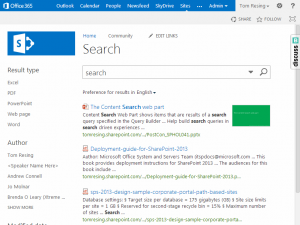
Re-Factor
Personally, I’ve used the Core Results Web Part to aggregate Document Results before, but I don’t remember needing to resort to custom code. Generally, if something can reasonably be done by configuration, I always recommend that over custom code. In this case, I’d suggest re-factoring the solution to determine if the custom web part can be removed. The core results web part is meant to be extensible through modifications to it’s web part properties, the managed search properties and XSLT.
Having said that, neither modifying the existing custom code nor configuring the core results web part are simple enough that I would try to explain in a short time. There’s a lot to consider and for the first time developer of this type of change, a bit of reading I’d recommend before starting.
Reading
First, my suggestion is to review the Microsoft documentation on the Core Results Web Part. TechNet Article Change how search results appear in the Search Core Results Web Part (Search Server 2010) provides a good introduction to the web part and what the best options are for changing it.
After exhausting Microsoft’s official documentation and any SharePoint books I have handy, I wouldn’t hesitate to recommend reading the blogs of two fellow Texan SharePoint MVPs. In this case, the MVP blogs go much deeper than anything on Microsoft.com and there are some very high quality posts on the subject by experienced SharePoint developers.
Corey Roth
Corey writes quite a lot about SharePoint Search in general. Just check out the Enterprise Search tag set on his blog. In particular, I might start with two posts specific to the Core Results Web Part:
Using search to find recently modified files in SharePoint 2010
A quick guide to CoreResultsWebPart configuration changes in SharePoint 2010
Matthew McDermott
Between Matthew and Corey, South Texas is well covered in SharePoint Search developers. On Matthew’s blog, I’d start with a search on Core Results which currently shows more than 10 posts on the subject. In particular, I recommend two articles, the first showing a very helpful troubleshooting step and the second showing a unique customization related to the reader’s question.
Create a XML Test Page for Search Results
Show Presence in SharePoint Search Results
Summary
SharePoint Development presents many unique challenges and requires a good understanding of the platform to develop solutions that are efficient and maintainable. I recommend reading about the problem area before starting a new SharePoint Development project. There is so much to learn.
The Core Search Results Web Part is very powerful. Building a solution around it justifies some investment of time learning before coding. While it is always possible to write your own custom code that does something that SharePoint already does, the trade off is too much for me in most cases. Instead, I recommend configuration, which arguably is still complex web development in this case, because it probably requires XSLT to be written and content type and search property GUID’s to be identified.
Microsoft provides a wealth of articles on MSDN and TechNet which are a primary reference. There are many SharePoint Development Books available, some are even search specific. On top of those resources, the SharePoint Community provides quality content that can’t be overlooked.




Tom Resing's Collaboration Blog
- Thomas Resing's profile
- 19 followers


